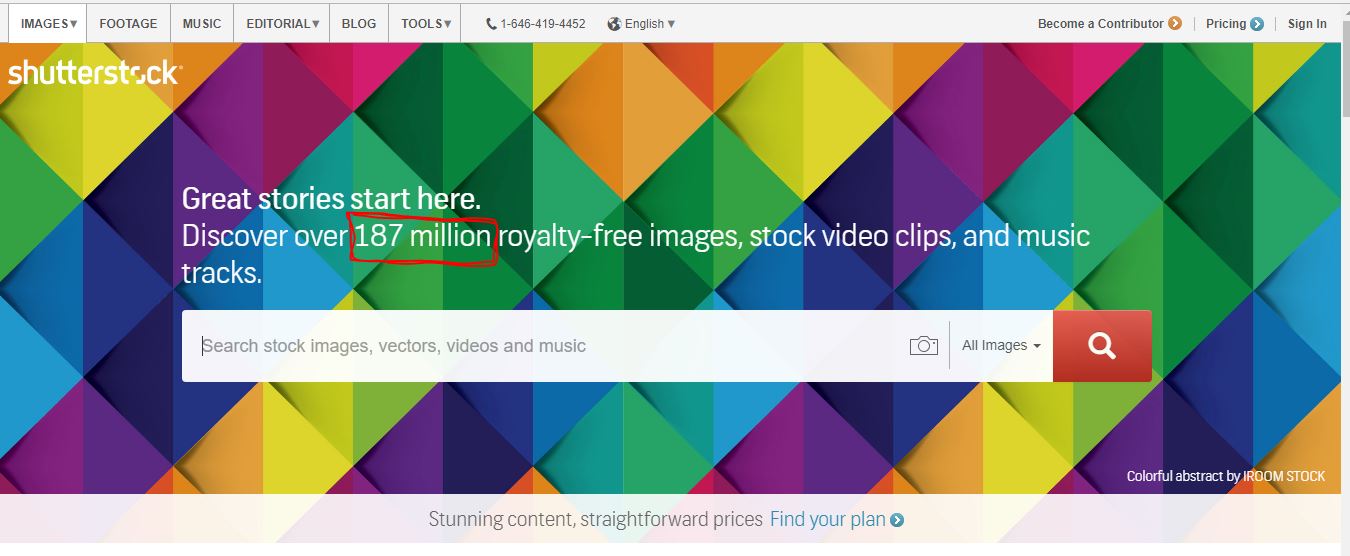If you’ve ever wondered whether you can turn your passion for photography, graphic design, or illustration into a side income, Shutterstock might just be the platform for you. As one of the world’s leading stock photo agencies, Shutterstock offers creative individuals a chance to showcase their work and earn money whenever someone licenses their images, videos, or vectors. Whether you’re a hobbyist looking to make a little extra cash or considering turning your creative pursuits into a part-time gig, understanding how
Understanding Shutterstock’s Contributor Program

Shutterstock’s Contributor Program is designed to make it straightforward for creatives to upload their work and start earning. When you sign up as a contributor, you become part of a vast community of artists, photographers, and designers who upload images that are then available for licensing worldwide. But how does the earning part work? Here’s a breakdown:
- Signing Up: It’s free to join. You simply need to create an account, agree to Shutterstock’s terms, and upload your first assets.
- Uploading Content: Quality matters! Shutterstock prefers high-resolution images, original content, and files that meet their technical standards. You can upload images, videos, vectors, and illustrations.
- Review Process: Uploaded content goes through a review process where Shutterstock’s team checks for quality and originality. Once approved, your work goes live on the platform.
- Earning Money: When someone licenses your content, you earn a royalty. The amount varies based on several factors, including your contributor level, the type of license purchased, and the total earnings you’ve accumulated.
One of the coolest aspects is that Shutterstock operates on a royalty-based system, meaning the more your content is downloaded, the more you earn. Plus, as you submit more high-quality content and build your portfolio, there’s potential to increase your earnings and even unlock higher commission rates. It’s a flexible program that lets hobbyists dip their toes in the water and gradually scale up as they gain experience and confidence. Whether you’re uploading a few images here and there or aiming to build a steady stream of income, understanding the ins and outs of the contributor program can help you maximize your earning potential on Shutterstock.
Factors Influencing Your Earnings on Shutterstock

When it comes to earning money on Shutterstock as a hobbyist, there’s no one-size-fits-all answer. Your income can vary quite a bit depending on several key factors. Let’s break down what can influence your earnings so you can get a better idea of what to expect and how to maximize your potential.
Quality of Your Content: First and foremost, high-quality images, illustrations, or videos tend to perform better. Shutterstock values content that is sharp, well-composed, and relevant. Investing a little extra time in editing and ensuring your submissions meet professional standards can make a big difference in sales.
Consistency and Volume: The more assets you upload, the higher your chances of making sales. Regularly adding fresh content keeps your portfolio active and increases the likelihood that buyers will discover and purchase your work. However, remember that quality should never take a backseat to quantity.
Keywording and Metadata: Properly tagging your images with accurate and descriptive keywords helps buyers find your content. Think about what someone would type into the search bar if they were looking for what you’ve created. Well-optimized metadata can significantly boost visibility and sales.
Content Niche and Trends: Some niches sell better than others. For example, business-related images, lifestyle photos, or trending topics like remote work and sustainability might fetch higher sales. Keeping an eye on current trends and creating relevant content can give you an edge.
Licensing and Sales Volume: Shutterstock offers different licensing options—standard and enhanced. The type of license purchased affects your royalty rate. Also, the more downloads your content gets, the more you earn. Building a diverse and appealing portfolio can help increase your overall sales volume.
Contributor Level: Shutterstock has a contributor level system that rewards active contributors with higher payout rates as they upload more content and maintain quality standards. Being consistent and improving your skills can help you climb these levels, boosting your earnings over time.
In summary, your earnings on Shutterstock as a hobbyist can be influenced by the quality of your content, how often you upload, how well you optimize your metadata, your niche, and your sales volume. While it’s not a guaranteed income, understanding these factors can help you make smarter decisions and potentially increase your earnings over time.
Average Earnings for Hobbyist Contributors

If you’re considering contributing to Shutterstock as a hobby, you might be wondering, “How much can I expect to earn?” The truth is, earnings can vary widely based on how much you contribute, the quality of your work, and other factors we discussed earlier. But to give you a ballpark idea, let’s look at what hobbyist contributors typically see in their accounts.
Most hobbyist contributors earn anywhere from $25 to $200 per month. For those just getting started or uploading sporadically, earnings tend to be on the lower end, around $25 to $50. As you build your portfolio and gain more visibility, those numbers can increase.
Here’s a quick breakdown:
| Contributor Level | Estimated Monthly Earnings |
|---|---|
| Beginner/Hobbyist | $10 – $50 |
| Intermediate | $50 – $150 |
| Advanced/Professional | $150 and above |
Keep in mind, these figures are approximate, and many hobbyists earn less or more depending on their efforts and niche. Some contributors report making a few dollars a month from their first uploads, while others with a larger, well-optimized portfolio can reach hundreds or even thousands over time.
It’s also worth noting that Shutterstock pays royalties based on the number of downloads and the licensing type. For hobbyists, the average royalty per download might be around $0.25 to $0.45 for standard licenses. So, if you get a handful of downloads each month, that can add up.
Ultimately, contributing to Shutterstock as a hobby can be a rewarding way to earn some extra cash while doing something you enjoy. While it may not replace a full-time income right away, with patience and persistence, your earnings can grow steadily. Remember, every contributor’s journey is unique—so keep creating, learning, and uploading!
Tips to Maximize Your Income on Shutterstock as a Hobbyist
So, you’re passionate about photography or creating digital art, and you’re interested in turning that hobby into a way to earn some extra cash on Shutterstock. While it’s not a full-time gig for most hobbyists, there are definitely ways to boost your earnings and get the most out of your uploads. Here are some handy tips to help you maximize your income:
Focus on Quality Over Quantity
Shutterstock values high-quality images. Instead of uploading hundreds of average shots, take your time to craft and select only the best ones. Sharp, well-lit, and professionally composed images tend to perform better and attract more buyers. Remember, a single standout image can generate more downloads than ten mediocre ones.
Stay on Top of Trends
Pay attention to what’s trending in the stock photo world. Whether it’s certain themes like remote work, sustainability, or wellness, creating content that aligns with current demand can boost your downloads. Browse Shutterstock’s popular categories and see what types of images are in high demand.
Use Relevant Keywords and Descriptions
Effective keywording is key to getting your images seen. Be descriptive and specific when tagging your uploads. Think about what a buyer might search for—use words related to the subject, mood, color, location, and concept. The more accurate your keywords, the higher the chances your images will appear in search results.
Upload Consistently
Keep a steady flow of new images coming. Regular uploads can help you stay relevant and increase your chances of earning more over time. It also signals Shutterstock that you’re an active contributor, which can improve your visibility in the contributor community.
Engage with the Community
Join Shutterstock forums or social media groups for contributors. Sharing tips, feedback, and experiences can provide new insights and motivate you to improve your craft. Plus, networking can sometimes lead to collaborations or special opportunities.
Leverage Your Unique Style or Niche
If you have a particular style, theme, or niche you’re passionate about, focus on creating content around that. Niche markets often have less competition and more dedicated buyers. Whether it’s macro photography, vintage designs, or travel scenes, specializing can help you stand out.
Pros and Cons of Earning Money from Shutterstock as a Hobby
Turning your hobby into a source of income on Shutterstock can be exciting, but it’s important to weigh the benefits and drawbacks. Here’s a quick rundown of the main pros and cons:
Pros
- Passive Income Potential: Once your images are uploaded and approved, they can generate income over time with minimal ongoing effort. This means you can earn money even when you’re not actively working.
- Flexibility and Freedom: You decide what and when to upload. There’s no strict schedule, making it perfect for hobbyists who want to keep it casual.
- Skill Development: Contributing regularly helps improve your photography or design skills. Over time, you’ll learn what sells best and how to create more marketable content.
- Global Reach: Shutterstock’s international customer base means your work can be seen—and purchased—by people all over the world.
Cons
- Variable Earnings: Income can be unpredictable, especially as a hobbyist. Some months may bring a decent payout, while others might be slow.
- Time Investment Without Guaranteed Payoff: Creating high-quality images takes time, and there’s no guarantee they’ll sell. It’s possible to spend hours on a project that doesn’t generate income.
- Competition: Shutterstock hosts millions of images, so standing out can be tough. It requires consistent effort and strategic keywording.
- Acceptance Process: Not every submission gets approved. Shutterstock has standards, and rejection can be discouraging, especially when just starting out.
Overall, earning on Shutterstock as a hobby can be rewarding if you approach it with realistic expectations. It’s a great way to turn your creative passion into a supplementary income stream, but it’s not a get-rich-quick scheme. Patience, quality content, and a strategic approach are your best tools for success.
Conclusion and Final Thoughts on Hobbyist Earnings
In summary, earning from Shutterstock as a hobbyist can be a rewarding experience, but it largely depends on your dedication, quality of work, and consistency. While some hobbyists may earn a modest side income, others with a strong portfolio and strategic approach can generate a significant supplementary income. It’s important to set realistic expectations and recognize that success often requires patience and continuous improvement.
Key factors influencing your earnings include:
- Quality of Content: High-quality images, videos, and illustrations attract more buyers.
- Frequency of Uploads: Regular uploads increase visibility and sales potential.
- Keyword Optimization: Proper tagging helps your content reach the right audience.
- Market Trends: Staying updated with popular themes and niches enhances your chances of sales.
While some hobbyists report earning a few hundred dollars annually, others have achieved monthly earnings exceeding several thousand dollars. It’s essential to view Shutterstock as a platform to develop your skills, build a portfolio, and enjoy the creative process. With persistence and strategic effort, hobbyists can turn their passion into a consistent source of income, making it an enjoyable and potentially profitable pursuit.


